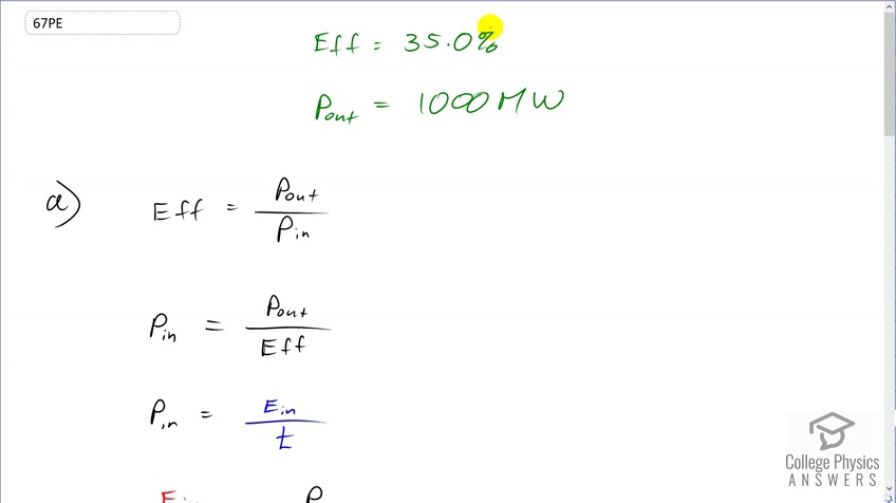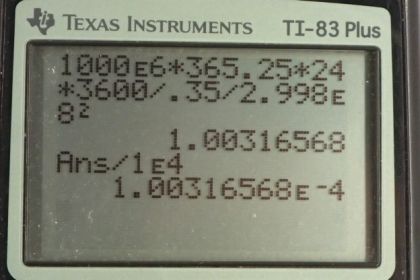Question
(a) A nuclear power plant converts energy from nuclear fission into electricity with an efficiency of 35.0%. How much mass is destroyed in one year to produce a continuous 1000 MW of electric power? (b) Do you think it would be possible to observe this mass loss if the total mass of the fuel is ?
Final Answer
- 0.01%. 1 kg is observable with careful measurement, but a very precise scale would be needed that has 6 digits of precision.
Solution video
OpenStax College Physics for AP® Courses, Chapter 28, Problem 67 (Problems & Exercises)

vote with a rating of
votes with an average rating of
.
Calculator Screenshots
Video Transcript
This is College Physics Answers with Shaun Dychko. A nuclear power plant has an efficiency of 35 percent. So of the energy that is created as heat due to the nuclear fission, 35 percent of that gets turned into electricity. The output of the power plant is 1000 megawatts for an entire year. So we are going to use this expression for efficiency to figure out what the power input is to the system. This is the rate at which heat energy is produced and this is the rate at which electrical energy is output. And then we'll rearrange this for P in and then we'll substitute the energy input over time is another way of expressing power input and equate this with this expression from our efficiency formula. And then we'll have this e equals mc squared formula rearranged for mass and then substitute our energy into that and then calculate the amount of mass that is turned into energy. OK. If we go through it slowly, it'll make more sense if that was too fast there that was just an overview. So efficiency is the ratio of the power output divided by the power input and we can multiply both sides by P in over efficiency to solve for P in. So power input is power output divided by efficiency. The power input is also the energy input divided by time; it's the rate at which energy is created by fission, the heat energy. And so we can equate this with that and we do that here because both of these are equal to power input. And then we'll multiply both sides by time here and we get that the energy input is the power output times time divided by efficiency. Now the energy is also the amount of mass that has been turned into energy times mc squared and we'll divide both sides by c squared to solve for Δm. So Δm is energy over c squared and the energy we are concerned with is this energy input, this heat energy created by fission which we'll then substitute for E in here. So the amount of mass turned into energy is the power output times time divided by efficiency times speed of light squared. So that's 1000 megawatts, written as 1000 times 10 to the 6 watts multiplied by the time which is 1 year and 1 year is multiplied by 365 and a quarter days per year times 24 hours per day times 3600 seconds per hour and the units all cancel here to work out to seconds. And then this numerator has units of joules then we divide that by—0.350—efficiency times the speed of light— 2.998 times 10 to the 8 meters per second— and then we square that and this gives 1.00 kilograms. Now in part (b), we are asked to figure out what ratio does this mass that is converted into energy as a ratio of the total mass that we started with. So we are told that there are ten thousand kilograms of Uranium here and 1.003166 kilograms divided by that is 0.01 percent. And this 1 kilogram should be observable but you would have to have a measuring device that is precise to 6 significant digits because the initial mass is 10,000 and in order to notice changes in this decimal place here, we'll need to have it precise to at least the tenths place.
